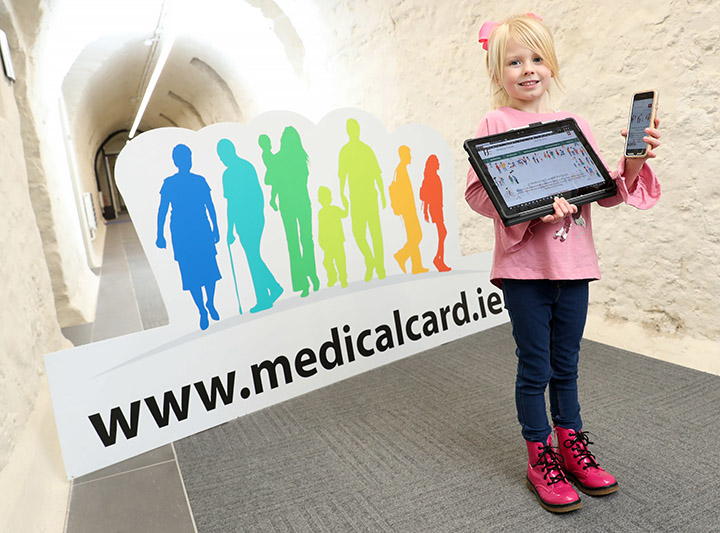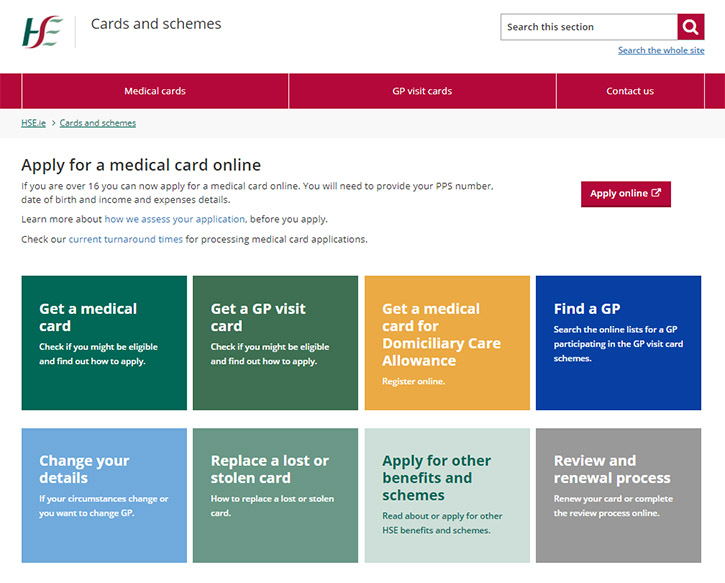Published by Andy Osborn, Digital Content Lead

About 50% of people in Ireland will use the medical cards or GP visit card schemes at some stage of their lives.
One of our first content design projects has been creating content that explains how people can apply for a medical card or a GP visit card.
This content was top of our list because it’s important to so many HSE.ie users. In 2017, there were over 900,000 page views of medical cards content and it was among the top-four ranking areas on the site.
Since we’ve launched the re-designed content, we have significantly increased user satisfaction rates, but decreased the number of pages and words needed to explain the service.
Start with research
First, to challenge our own assumptions about what our users need, we conducted some research. We looked at various sources, including:
- On-page user feedback and comments
- Call centre and web chat data from HSE Live
- Data from incomplete applications for cards
- Website analytics
- Search keyword analysis
It became clear that many people were finding it difficult to understand some of the information and to complete tasks efficiently. Many users were having the same frustrations, so our mission was to try to address these with the new and improved content.
User stories
Before creating content, we mapped out all the different schemes and services delivered by the HSE Primary Care Reimbursement Service (PCRS). PCRS manage the medical card and GP visit card schemes. Some services are quite similar and others are very different.
Identifying the information that applied to the majority of people, or multiple different user groups helped us to avoid duplication in our content.
We then developed user stories with subject-matter experts at PCRS.
Here’s an example of one of the user stories:
- As a … person over 70
- I want to … know what documents I should include with my medical card application
- So I can … submit a fully completed application.
Our user stories helped us to stay focused on the task our user is trying to complete. Our content should support this.
Designing content
Armed with a pile of user insights and knowledge about how the service operates, we began creating content.
This content went through two drafts and two internal reviews by content designers to ensure we were staying in-line with our content guide.
Plain English
Everything we publish is written in plain English. Plain English is a style of writing that helps the reader to understand it the first time they read it.
To do this, we use short, simple words and we write short, clear sentences. This lowers the overall word count and reduces the amount of time the user needs to complete their task.
Increasing readability
We measure how easy (or difficult) it is to read our content. We analyse our content’s vocabulary, syntax and sentence length. For public service content, like the medical cards content, we aim for a reading age of 9.
Some of the previous content had a readability score of over 18.
No marketing on the site
Marketing style language does not feature in our new web content. While people are trying to complete a task on our website, we don’t need to waste their time with marketing messages. All they need is information that helps them get things done.
Marketing style content works well on other channels, like social media, to raise awareness and direct people to the content.
No FAQs
FAQs, or Frequently Asked Questions, are used on many websites. But they’re not very user-friendly. Often crucial information gets buried in FAQs and users don’t see it.
As a user, sifting through long lists of questions in order to find a piece of content takes much longer than it does to scan pages that are well structured with meaningful headings.
And for content publishers, FAQs can become dumping grounds and lead to duplication of information.
Fact check
Our colleagues in PCRS worked with us to fact check our content to make sure our edits hadn’t changed the accuracy of it.
Testing
We conducted two rounds of testing before going live.
1. Paper testing
We printed out the new content pages and asked users for their feedback. There were some surprises here which informed our next iteration of the content.
2. Usability testing
We asked users to perform tasks on a private development site with our new content on it. We could see where users were having difficulty and adjust the content, site structure and user journey to improve their experience.
Launch
The new medical cards and GP visit cards section went live on 15 January 2018.

Results
When we went live with our new content, we had cut the number of:
- words from 18,706 to 5,399
- pages from 44 to 25
On 15 January 2018, PCRS launched a new medical cards online application system which was promoted online and on radio.
The following day, 81,000 people visited the site. This was the highest number of daily visits to HSE.ie since 1 February 2017.
We are excited to see that since launching the new site we have had a 31% increase in user satisfaction.
Next steps
Content design is an iterative process and this content is so frequently used that it will always be a high priority for us.
We’ll be keeping a close eye on our new medical cards content and doing more testing so we can continue to improve it. We want HSE.ie users to understand this service and have the best possible online experience.